It's a question which has troubled some of the finest minds of our age: what do you get for the only self-confessed Darwin groupie in your life when they hit the Big Five-O?
Shortly after my partner, Jen, and I returned home from a week-long holiday in Venice celebrating my 50th birthday, I received a phone call from my friend beyond compare, Stense. It turned out that she had been organising a special birthday treat for me. Stense is good at that sort of thing. A few weeks later, having travelled down from Yorkshire and Scotland in the early hours, the two of us met outside the Natural History Museum in London. After a quick exchange of hugs and good to see yous, we hurried through the visitors' entrance to meet Dr Martin Munt, Head of Palaeobiology Collections at the Department of Earth Sciences. Stense had arranged for Martin to show us some fossils collected by none other than Charles Darwin—many of them on the Beagle voyage. Have I got the best friends in the world, or what?
After viewing a few non-Darwinian fossils described by one of the legendary-in-fossil-describing-circles Sowerbys, we headed off towards the barnacles section. As Martin led us through the maze of filing cabinets, I explained to Stense how a throwaway remark by Darwin's own friend beyond compare, Joseph Dalton Hooker, had inadvertently touched a raw nerve. In a letter to Darwin in 1845, Hooker had described a certain French scientist, who had made some howler in a recent paper, as ‘no Botanist’; a man who ‘[did]not know what it is to be a specific Naturalist himself’. Darwin had long worried that, as he had not established his biological credentials by studying any group of species in depth, his as-yet-unpublished species theory would not be taken seriously. Hooker's throwaway comment was to launch Darwin on an eight-year study of living and extinct barnacles. The books he wrote are still the definitive books on the subject.
We arrived at a cabinet identical, as far as I could tell, to all the other cabinets. Martin took out his keys and unlocked it, sliding open the door to reveal a set of drawers labelled CIRRIPEDIA: Balanomorpha. Inside each drawer were dozens of small cardboard boxes containing all manner of fossilised barnacles, many on them on the fossilised shells of other species.
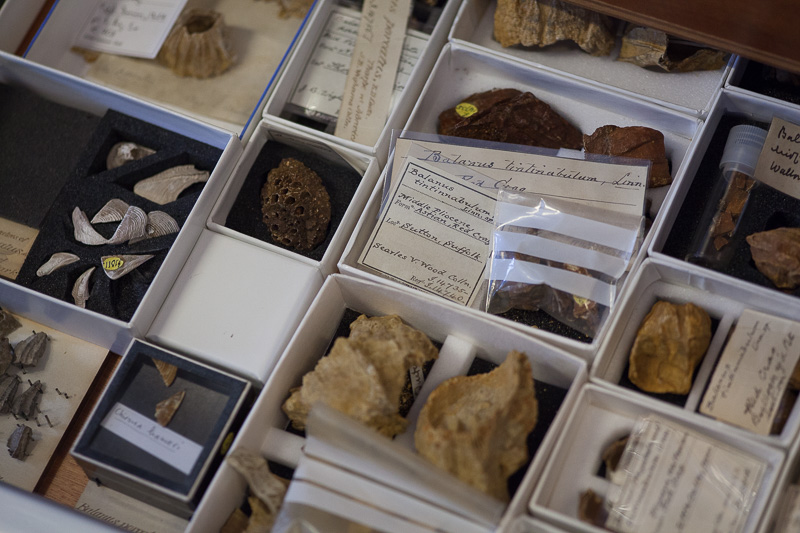
Martin explained that the museum's specimens tend to be stored according to biological taxonomy, rather than by who collected them, so Darwin's stuff is scattered throughout the building, often being stored amongst related samples from other collectors. We were then joined by Claire Mellish, Curator of Fossil Arthropods, who explained that many of Darwin's fossils had been given new labels over the years, although some still bore his original handwriting. One thing to look out for, she said, is Darwin's characteristic long, high crossbar on his lower-case letter ‘t’s. Claire located a fossil labelled Balanus crenatus in Darwin's handwriting, and arranged it in the drawer for me to photograph. When I Googled Balanus crenatus afterwards, I was delighted to learn that it is still a common species of acorn barnacle—most likely one of the very species I used to graze my knees on when rockpooling in Anglesey as a child.
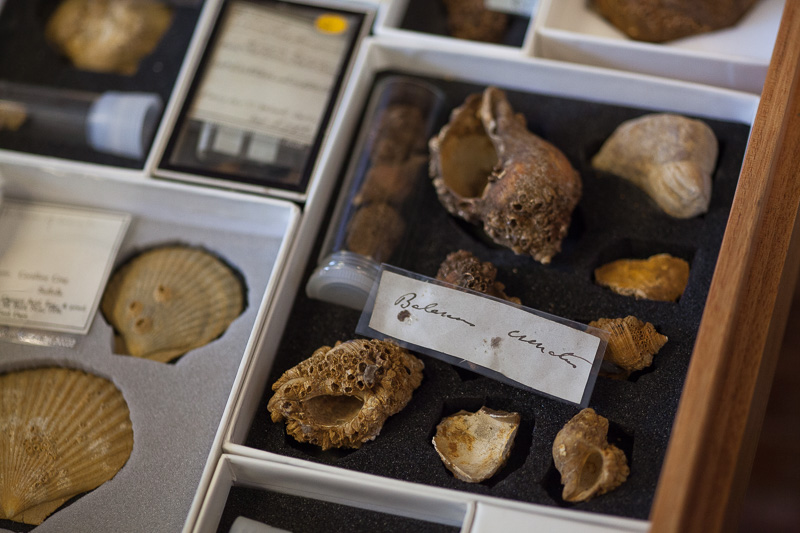
While looking over the barnacles, I took the opportunity to share a favourite Darwin story. So obsessed did Darwin become with his barnacle studies during the years 1846 to 1854 that, according to family legend, one of Darwin's young children, on visiting a neighbour's house, is supposed to have asked where the gentleman of the house did his barnacles.
In his autobiography, written towards the end of his life, Darwin described how he first came to take an interest in Cirripedia (barnacles), voicing a suspicion that his obsession had earned him a place in literary parody:
In October, 1846, I began to work on 'Cirripedia.' When on the coast of Chile, I found a most curious form, which burrowed into the shells of Concholepas, and which differed so much from all other Cirripedes that I had to form a new sub-order for its sole reception. […] To understand the structure of my new Cirripede I had to examine and dissect many of the common forms; and this gradually led me on to take up the whole group. I worked steadily on this subject for the next eight years, and ultimately published two thick volumes (Published by the Ray Society.), describing all the known living species, and two thin quartos on the extinct species. I do not doubt that Sir E. Lytton Bulwer had me in his mind when he introduced in one of his novels a Professor Long, who had written two huge volumes on limpets.
After I had taken a few more photographs, Martin led Stense and me further into the maze of cabinets, into one of his own areas of expertise, the fossil molluscs. He slid open another cabinet door to reveal the coolest labels I have ever seen on a set of drawers:
Charles Darwin Coll.
Voyage of the Beagle figd specimens
The individual drawers were further labelled Oysters, Bivalvia, and Gastropoda.
Martin explained that some of Darwin's specimens were seen as scientifically important (for example, when they were the original ‘type’ specimens defining new species); whereas other specimens, while not being especially important scientifically were still seen as historically important, on account of who collected them. The specimens in these drawers were both scientifically and historically important. Some of them were also rather beautiful.
Martin drew our attention to what he said was probably his favourite fossil collected by Darwin: that of a slipper limpet, collected in S. Cruz, Patagonia in 1834. It really was an odd-looking creature—or, as I later found out, stack of creatures layered one on top of another—resembling, to my inexpert eyes, something more akin to a modern art sculpture than a cluster of fossilised organisms.
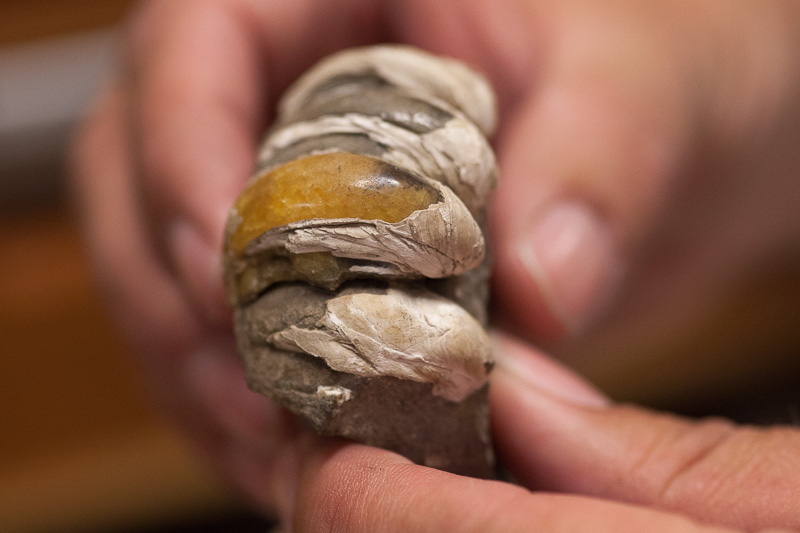
There were dozens of other fossils from the Beagle voyage in the drawers, including some still labelled in Darwin's handwriting, such as that of the type specimen of the bivalve Nucula ornata, which he collected at Port Desire in Patagonia.

Thoughtfully, some previous visitor—a curator, I suppose—had left photocopies of the engraved plates from Darwin's 1846 book Geological Observations on South America, which depicted many of the actual fossils stored in the drawers. The illustrations of the fossils, and their descriptions, came courtesy of G.B. Sowerby (one of the aforementioned, legendary-in-fossil-describing-circles Sowerbys). The photocopies had evidently been used in some sort of fossil stock-taking exercise, as there were lightly pencilled ticks against many of the images. There, on plate 2, figure 19, was the Nucula ornata fossil I had just photographed, and there on plate 3, figure 34, was Martin's slipper limpet, Crepidula gregaria.
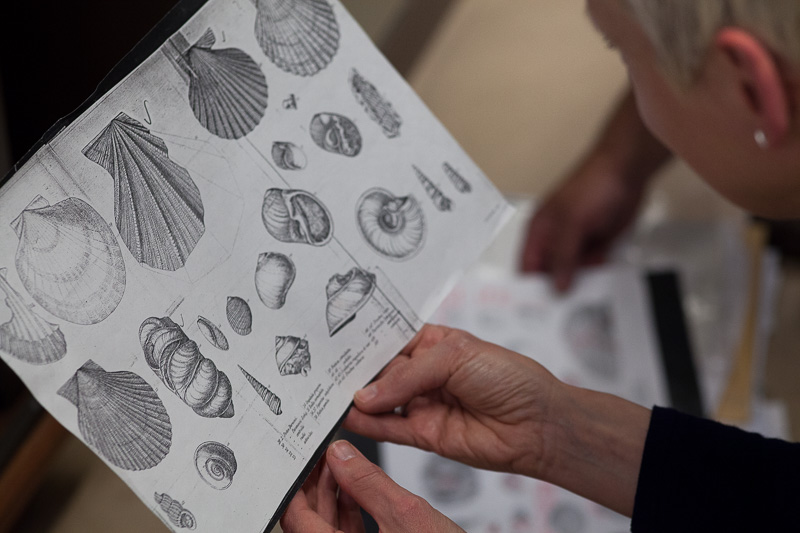
Sowerby described Crepidula gregaria as follows:
This species is remarkable for its lengthened form: it is found, grouped together in an argillaceous sandstone of a grayish colour. It bears a strong general resemblance to Crepidula fornicata, which is found, similarly grouped, on the coasts of New York, New England, and generally on the Atlantic coasts of N. America.
Martin explained that slipper limpets have now established themselves in certain areas on the south coast of England, having been transported from their natural habitats in ships' ballast.
For our final set of Darwin fossils, Martin led us yet further into the maze, to the Brachiopods section. Brachiopods are an ancient lineage of sea-dwelling bivalves which superficially resemble clams—although they're not actually molluscs. I have a strange soft-spot for brachiopods, having once imagined seeing the image of Charles Darwin in a fossilised cluster of them. Yes, I know, I really should get out more. The brachiopods Martin had brought us to see were collected by Darwin just south of Port Louis in the Falkland Islands on 22nd March, 1833.
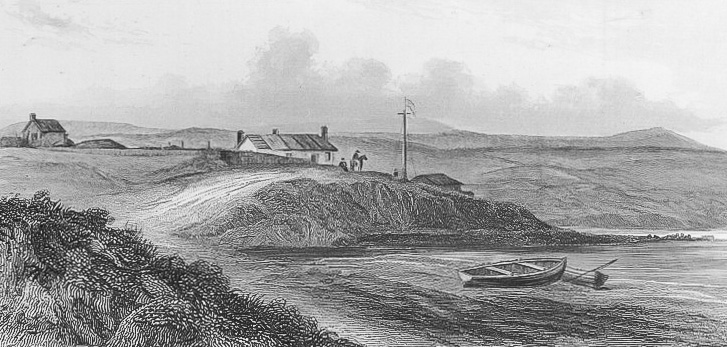
From: Robert FitzRoy's Narrative of the Surveying Voyages of His Majesty's Ships Adventure and Beagle between the years 1826 and 1836.
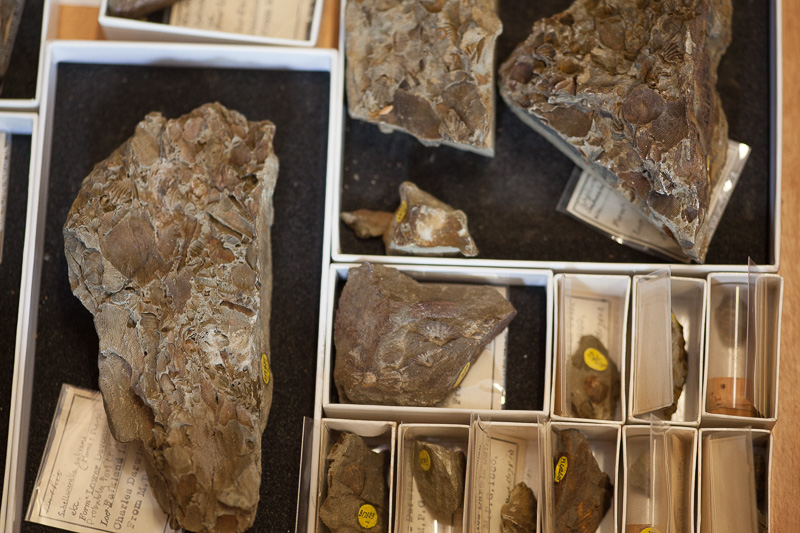
Darwin recorded collecting these very fossils in his Beagle diary, stating:
This is one of the quietest places we have ever been to. — […] I walked one day to the town, which consists in half a dozen houses pitched at random in different places. […] The whole aspect of the Falkland Islands, were however changed to my eyes from that walk; for I found a rock abounding with shells; & these of the most interesting geological aera.
He explained the significance of his finds in a letter home to his sister Caroline, written aboard HMS Beagle a few days later:
I have been very successful in geology; as I have found a number of fossil shells, in the very oldest rocks, which ever have organic remains.— This has long been a great desideratum in geology, viz the comparison of animals of equally remote epocks at different stations in the globe.
As Chancellor and van Wyhe explain in their book Charles Darwin's Notebooks from the Voyage of the Beagle:
It is difficult to overstate the importance of these fossils. At the time of their discovery fossils like these were little known beyond Europe and were regarded as almost the oldest known life on Earth.
Martin picked up one of the rocks containing a couple of particularly pretty Spirifer hawkinsii brachiopods and handed it to Stense. He explained that this particular rock was the one traditionally handed to visitors. Previous handlers of this rock, in addition to Charles Darwin, were said to include King George V and Princess Diana. To which illustrious list can now be added Stense, followed shortly afterwards by Yours Truly.
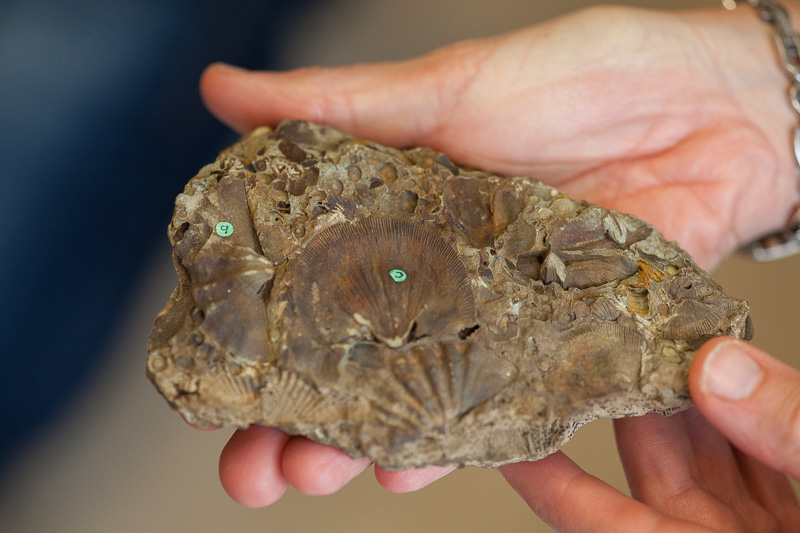
Darwin's Falkland Island fossils were eventually described by Morris and Sharpe in an 1846 paper in the Proceedings of the Geological Society. Their paper immediately followed one by Darwin on the Geology of the Falkland Islands, and included an engraving of the very fossil in Stense's hands.
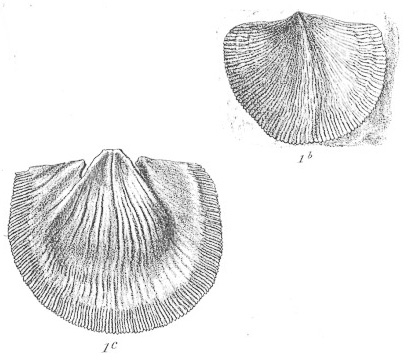
At the end of their paper, Morris and Sharpe concluded:
The number of species collected by Mr. Darwin from the Falkland Islands is too limited to justify any close comparison with the palæozoic fauna of other portions of the globe, still however their allocation is rather interesting: of the eight species above described, all belong to the family of Brachiopoda, which appear to have constituted the chief portion of the fauna of that locality, and there is also a species of Orbicula (Pl. X. fig. 5), too imperfect to be described […]
The general occurrence and extensive distribution of many species of Brachiopoda, either identical in character or analogous in form, in the palæozoic strata, has always been a subject deeply interesting to the palæontologist, and has given rise to the opinion, that a more equable temperature, a greater uniformity of physical character and surface arrangements may have been instrumental in producing this extension in the northern regions during the palæozoic period; and the valuable researches of Mr. Darwin have also revealed to us that the existing conditions of some portions of the southern hemisphere at the same æra were favourable to the development of other species of the family Brachiopoda nearly related to those which in Northern Europe characterise the rocks of the palæozoic æra.
Morris and Sharpe were writing in a time before the theory of plate tectonics, so did not appreciate that the land masses which would become Northern Europe and South America were considerably closer to each other in those days. They and Darwin believed these Falkland Island fossils to date from either the Silurian or Devonian geological period within the Palaeozoic era. We now know that they date from the Devonian, being approximately 386 million years old—from a time when the world's continents were arranged very differently to today, with the submerged section of the South American tectonic plate that would eventually become the Falkland Islands lying close to what would become southern Africa.
386 million years! And I thought turning 50 was pretty ancient!
As a final treat, on our way out of the building, Martin took the opportunity to show us some scientifically unremarkable, but historically important fossils collected by the geologist William Smith, creator of the first geological map of Great Britain. It was a timely reminder to this incorrigible Darwin groupie that there have been—and there still are—plenty of other hard-working, less-hallowed scientists finding out how the world works, in addition to our Charlie. According to its website, the Natural History Museum houses 80 million scientific specimens. Every single one of those specimens had to be collected by somebody, examined and curated, named, and perhaps written about. Many of them will be of considerably less historical interest than Darwin's famous specimens, but they will all have their own fascinating stories to tell.
✽
Acknowledgements:
Thanks to Dr Martin Munt of the Natural History Museum for finding time to show us around, and to his colleague Claire Mellish for helping me finally to get an inkling of what Darwin saw in barnacles. And extra-special thanks to Stense for being a friend beyond compare for exactly half of my 50 years, and for having such wonderful ideas for birthday presents.
References:
- Burkhardt, F.H. & Smith, S., eds. (1985). The Correspondence of Charles Darwin, vol. 1, 1821–1836. Cambridge University Press.
- Burkhardt, F.H. & Smith, S., eds. (1988). The Correspondence of Charles Darwin, vol. 3, 1844–1846. Cambridge University Press.
- Chancellor, G. & van Wyhe, J., eds. (2009). Charles Darwin's Notebooks from the Voyage of the Beagle. Cambridge University Press.
- Darwin, C.R. (1846). Geological Observations on South America. Being the third part of the geology of the voyage of the Beagle, under the command of Capt. Fitzroy, R.N. during the years 1832 to 1836. London: Smith Elder and Co. (Available at Darwin Online.)
- Darwin, F., ed. (1887). The Life and Letters of Charles Darwin, including an autobiographical chapter. London: John Murray. (Available at Darwin Online.)
- FitzRoy, R. (1839). Narrative of the surveying voyages of His Majesty's Ships Adventure and Beagle between the years 1826 and 1836, describing their examination of the southern shores of South America, and the Beagle's circumnavigation of the globe. Proceedings of the second expedition, 1831-36, under the command of Captain Robert Fitz-Roy, R.N. London: Henry Colburn. (Available at Darwin Online.)
- Keynes, R. D., ed. (2001). Charles Darwin's Beagle Diary. Cambridge: Cambridge University Press. (Available at Darwin Online.)
- Morris, J., & Sharpe, D. (1846). Description of eight species of brachyopodous shells from the Palaeozoic rocks of the Falkland Islands. Quarterly Journal of the Geological Society 2: (25 March) 274-278. (Available at Darwin Online.)
Further reading:
- Herbert, S. (2005). Charles Darwin, Geologist. Cornell University Press.
- Keynes, R. (2002). Fossils, Finches and Fuegians: Charles Darwin's Adventures and Discoveries on the Beagle, 1832–1836. London: Harper Collins.
- Stott, R. (2003). Darwin and the Barnacle: the story of one tiny creature and history's most spectacular scientific breakthrough. London: Faber and Faber.
What a treat!
Oh Barnicles! I love it! http://darwinskidneys.blogspot.com/
Great post. Here is the 'Professor Long' episode from Bulwer Lytton - http://www.literaturepost.com/chapter/14381.html